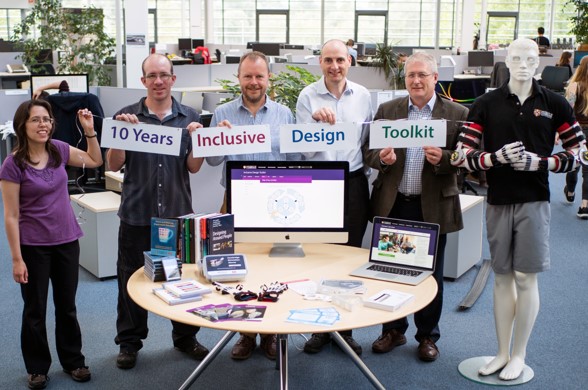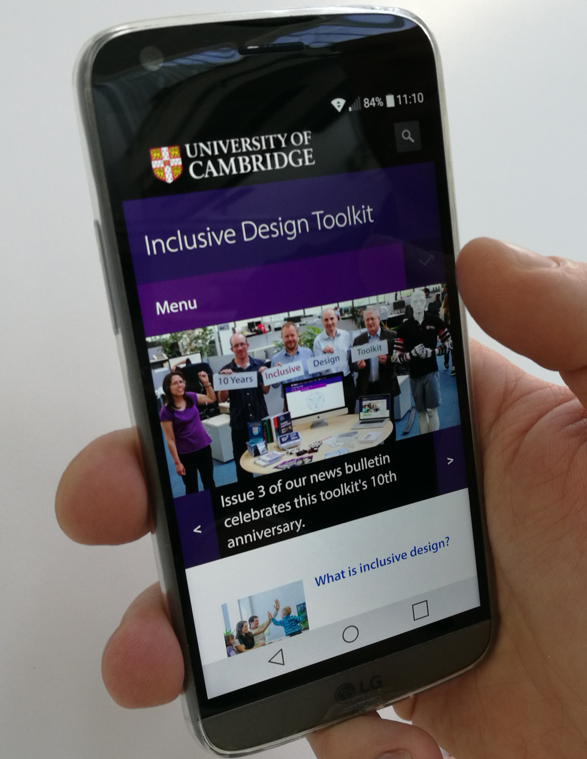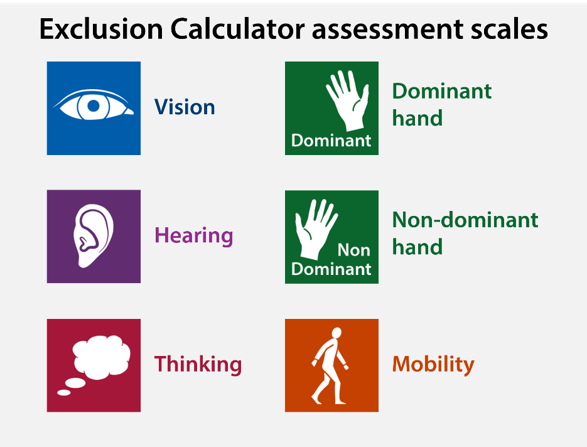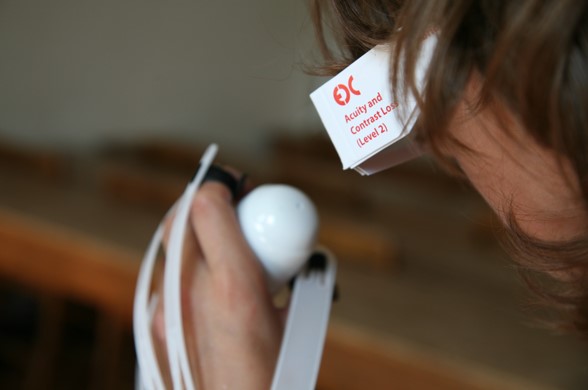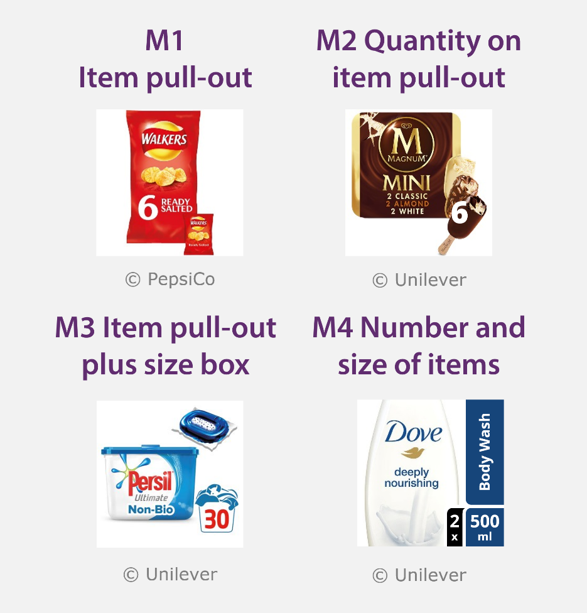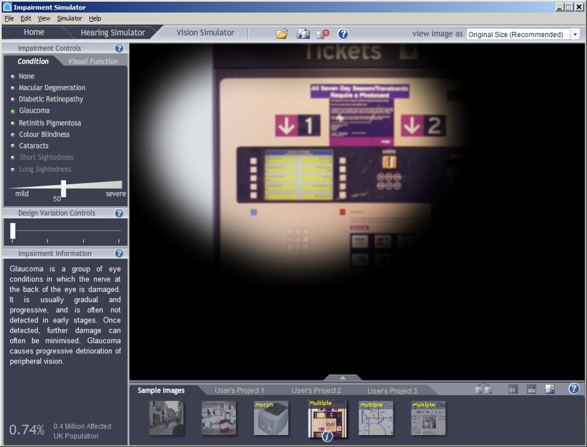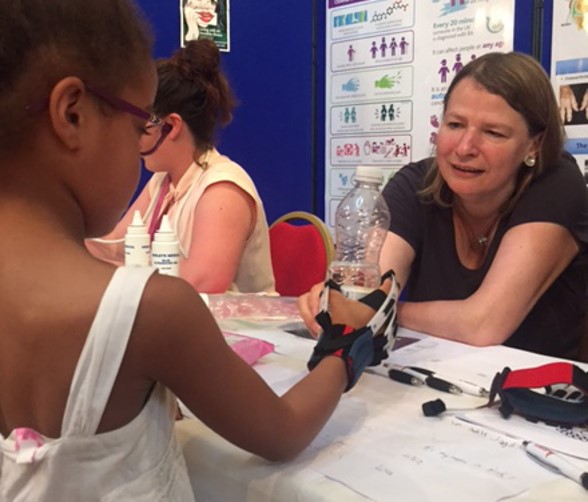Welcome to a special 10th anniversary edition of the Inclusive Design Toolkit news bulletin! The Inclusive Design Toolkit was launched in summer 2007, and we’re celebrating its 10th anniversary with a revamp of the website and an updated exclusion calculator.
If you would like to receive this bulletin on a regular basis, or contribute to it, then please fill in the feedback form at the bottom of this page
On this page:
- Tenth anniversary of the Inclusive Design Toolkit
- New exclusion calculator enables better assessments for vision and dexterity
- Inclusive design taught in design and technology lessons for secondary schools
- E-commerce image guidelines now cover multipacks
- Impairment simulator software now freely available
- Children try out simulation gloves at science festival
Tenth anniversary of the Inclusive Design Toolkit
The Inclusive Design Toolkit was launched in summer 2007. In the last 10 years, every section has been updated and expanded, and new tools have launched such as simulator gloves and glasses and the SEE-IT tool. The Toolkit website now averages 5000 monthly visits from over 70 countries, and approximately 900 simulator gloves and 6000 glasses have been sold.
For the 10th anniversary revamp of the website, the About users section has been restructured to focus on the ‘things to consider’ to accommodate different types of capability loss within a design process. The population statistics in this section have also been updated to use the scale descriptions from the new Exclusion calculator. In particular, the Reach and Dexterity section now has specific data for grasping, precision and reaching movements.
Furthermore, a new ‘Applied to’ section highlights the toolkit’s links with initiatives in areas such as education and sustainability. The website has also been updated with the new mobile friendly style.
For its 10th anniversary, the Inclusive Design Toolkit has been relaunched with new content and a new mobile-friendly style.
New exclusion calculator enables better assessments for vision and dexterity
The inclusive design toolkit’s new exclusion calculator has now launched at calc.inclusivedesigntoolkit.com, with the following enhancements:
- Vision assessments can now be performed using Cambridge Simulation Glasses, which dramatically improves consistency of assessment between different people.
- Dexterity assessments are now performed separately for the dominant and non-dominant hands, giving much greater flexibility in the kinds of tasks that can be assessed.
- All the scale descriptions used in assessments have been rewritten, to make them more specific and easier to apply. New icons have also been drawn to represent each scale point.
“
The EDC’s new Exclusion Calculator features a greatly improved user interface, making it quicker to carry out assessments and better for showing non-experts how an Exclusion Audit helps design teams to make informed decisions. ”
An advanced version of the calculator has also been developed, which additionally enables you to:
- Assess a user journey of multiple tasks.
- Save and export results.
- Calculate exclusion within Microsoft Excel.
If you would like to purchase a licence for this advanced version, please contact edc-toolkit@eng.cam.ac.uk
The new calculator was developed with kind support from the steering board of the third Inclusive Design Consortium run by the Centre for Business Innovation.
The new Exclusion Calculator now enables separate assessments for the dominant and non-dominant hands, in addition to considering vision, hearing, thinking and mobility.
Inclusive design taught in design and technology lessons for secondary schools
Designing Our Tomorrow (DOT) is about equipping early secondary school students (aged 11 to 14) with effective skills in creative thinking, engineering and design through examining authentic design problems. DOT delivers training for teachers and high quality resources for Design & Technology lessons. The resources are presented in DOT boxes, each of which is a 12-14 lesson scheme of work.
The recently launched Inclusive Salt & Pepper Scheme was developed to teach inclusive design principles from the Inclusive Design Toolkit. In it, students use the Cambridge Simulation Glasses and a low-cost version of the Cambridge Simulation Gloves to assess and improve the design of salt and pepper dispensers.
“
I feel like I am doing something for a purpose and it makes me feel happy that I am helping people. ”
See the DOT resources webpage for more information on this scheme, and other DOT schemes that are available for sale.
E-commerce image guidelines now cover multipacks
The Engineering Design Centre, in partnership with Unilever, have produced guidelines for Mobile Ready Hero Images. These are e-commerce product images that communicate critical information more clearly. More comprehensive guidelines have recently been launched at ecommerce.inclusivedesigntoolkit.com. The guidelines now include four standard layouts for use for all products, and an additional four layouts for multipacks.
In addition, detailed supplier guidelines now covers exactly what is and isn’t allowable within Mobile Ready Hero Images. The topics include allowable image manipulations and off pack communications, and a discussion on retailer-added overlays.
Our Mobile Ready Hero Image Guidelines now include multipacks.
Impairment simulator software now freely available
The Impairment simulator software is an installable application that enables you to:
- Apply simulated vision impairment to your own images, or any third party program running on your computer.
- Export the results to an image file, ready to insert into a presentation.
- Listen to audio clips with simulated hearing impairment.
Simulating impairment helps people to learn about different vision and hearing conditions, and communicate the corresponding real-world issues to others.
This software used to have a free version embedded in the website and a paid-for installable version. We are now supplying activation codes for the installable version free of charge. Please e-mail edc-toolkit@eng.cam.ac.uk, and we will reply with your activation code. The software also has a 14-day free trial period, before the activation code is required.
Children try out simulation gloves at science festival
The Centre for Experimental Medicine and Rheumatology (EMR) at Barts and the London School of Medicine and Dentistry recently participated in the Barts and Queen Mary University of London (QMUL) Science Festival. This is an annual event showcasing research and medicine, which was attended by over 400 children. Research fellows from EMR performed ultrasounds on the children so that they could ‘see inside’ their own joints and Cambridge University provided dexterity loss simulation gloves so that children and adults could get a sense of the effects of arthritis on everyday tasks.
“
I was delighted that we had the gloves available, they really helped the children understand what arthritis is like ”
Many could not believe how difficult everyday tasks become when joints are stiffened by arthritis. The stand was a great success with queues forming to try the gloves. No doubt this will be the first of many events that we will participate in.
EMR is part of the MATURA consortium, which includes academic groups and industry partners working together to help patients with rheumatoid arthritis.
Feedback
We would welcome your feedback on this page:
Privacy policy. If your feedback comments warrant follow-up communication, we will send you an email using the details you have provided. Feedback comments are anonymized and then stored on our file server. If you select the option to receive or contribute to the news bulletin, we will store your name and email address on our file server for the purposes of managing your subscription. You can unsubscribe and have your details deleted at any time, by using our Unsubscribe form. If you select the option to receive an activation code, we will store your name and email address on our fileserver indefinitely. This information will only be used to contact you for the specific purpose that you have indicated; it will not be shared. We use this personal information with your consent, which you can withdraw at any time.
Read more about how we use your personal data. Any e-mails that are sent or received are stored on our mail server for up to 24 months.


